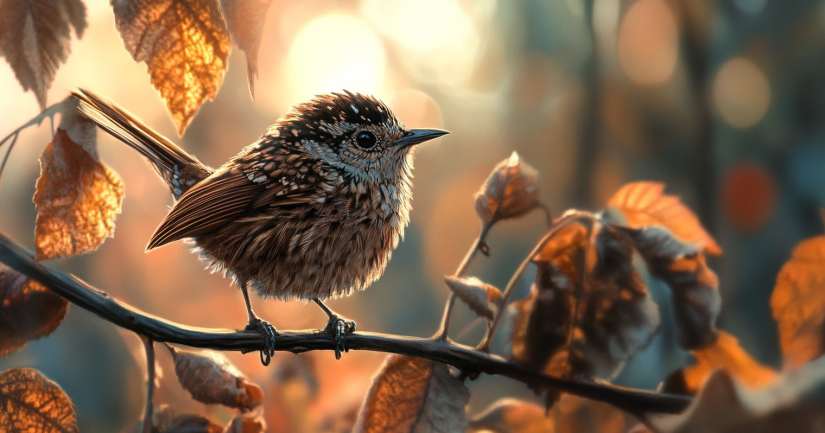
Fly into our Wren Quiz – How Well Do You Know These Tiny but Powerful Songbirds? Wrens may be small, but they are among the most energetic and vocal birds in nature. This Wren Quiz will test your knowledge of these tiny songbirds, known for their loud calls, quick movements, and curious nature. Found across forests, grasslands, and urban areas, wrens thrive in diverse habitats and play an important role in ecosystems.
Wrens belong to the Troglodytidae family, which includes over 80 species worldwide. Despite their size, they produce some of the loudest and most complex songs of any bird. The Carolina Wren, for example, can be heard from great distances, even in dense forests.
Wrens are sprightly, but there’s more to uncover! Discover the melodic warbler in the Warbler Quiz or the striking vulture in the Vulture Quiz.
Discover Your Results – Begin the Wren Quiz
What Makes Wrens Unique? Key Insights for the Wren Quiz
These birds are also known for their hyperactive behavior. They dart through underbrush, hop between branches, and frequently flick their tails upward. Their curiosity leads them to explore every corner of their territory in search of food.
Where Do Wrens Live? Exploring Their Habitat and Behavior
Wrens thrive in a variety of environments, from woodlands and marshes to gardens and city parks. Some species, like the House Wren, adapt well to human-made structures, often nesting in birdhouses, mailboxes, or even discarded boots. Others, like the Winter Wren, prefer dense forests where they can remain hidden.
Most wrens are insectivores, feeding on beetles, spiders, and caterpillars. Their small size allows them to forage in crevices and under logs, places larger birds cannot reach. This makes them valuable for natural pest control.
Why Are Wrens Important to Ecosystems?
Wrens contribute to insect population control, keeping gardens and forests balanced. Their foraging habits help reduce pests, benefiting plants and other wildlife.
They also play a role in seed dispersal. Some species consume small berries, spreading seeds as they travel through their habitat. Their energetic movements and constant vocalizations make them an essential part of any ecosystem.
Are Wrens in Danger? Conservation and Challenges
Most wren species have stable populations, but some face threats due to habitat loss, deforestation, and climate change. Urban expansion reduces nesting sites, making it harder for wrens to find safe shelter.
To help support wren populations, conservationists encourage:
- Providing nest boxes to offer safe nesting spots
- Planting native shrubs and trees for food and shelter
- Reducing pesticide use to protect their insect food sources
These simple actions help ensure wrens continue to thrive in natural and urban environments.
Are You Ready to Take the Wren Quiz?
Now that you’ve explored the songs, habitats, and survival skills of wrens, it’s time to test your knowledge! This Wren Quiz will challenge you with fun and fascinating questions about these lively birds. Can you recognize their calls and behaviors? Start the quiz now and find out!
Check out our FULL collection of Bird Quizzes!
Wren – FAQ
A wren is a small, primarily insectivorous bird belonging to the family Troglodytidae. They are known for their distinctive, energetic behavior and melodious songs. Wrens are found in a variety of habitats, including forests, grasslands, and gardens, across the Americas, Europe, and parts of Asia and Africa.
Wrens typically exhibit a compact body, short tail, and a slightly curved beak. They have brown or grayish plumage, often with streaks or spots that provide camouflage. Size-wise, most wrens measure between 3 to 5 inches in length. Their vocalizations are notably loud and varied, making them one of the most vocal bird families.
Wrens primarily feed on insects and other small invertebrates, although some species also consume seeds and berries. They are adept foragers, often seen flitting through vegetation or hopping along the ground. Their keen sense of hearing aids them in locating prey, which they capture with rapid movements.
While some wren species are solitary, many are quite social, especially during the breeding season. They may form small family groups and often engage in cooperative behaviors, such as defending territory and caring for young. Their social dynamics can vary significantly among species.
To attract wrens, consider providing suitable nesting sites, such as small birdhouses or dense shrubs. Offering a diverse range of native plants can also help, as they provide both food and cover. Additionally, maintaining a clean birdbath with fresh water will encourage these charming birds to visit your yard regularly.
